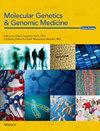Are asymptomatic carriers of OTC deficiency always asymptomatic? A multicentric retrospective study of risk using the UCDC longitudinal study database
IF 1.5
4区 医学
Q4 GENETICS & HEREDITY
引用次数: 0
Abstract
Abstract Background Ornithine transcarbamylase deficiency (OTCD) due to an X‐linked OTC mutation, is responsible for moderate to severe hyperammonemia (HA) with substantial morbidity and mortality. About 80% of females with OTCD remain apparently “asymptomatic” with limited studies of their clinical characteristics and long‐term health vulnerabilities. Multimodal neuroimaging studies and executive function testing have shown that asymptomatic females exhibit limitations when stressed to perform at higher cognitive load and had reduced activation of the prefrontal cortex. This retrospective study aims to improve understanding of factors that might predict development of defined complications and serious illness in apparent asymptomatic females. A proband and her daughter are presented to highlight the utility of multimodal neuroimaging studies and to underscore that asymptomatic females with OTCD are not always asymptomatic. Methods We review data from 302 heterozygote females with OTCD enrolled in the Urea Cycle Disorders Consortium (UCDC) longitudinal natural history database. We apply multiple neuroimaging modalities in the workup of a proband and her daughter. Results Among the females in the database, 143 were noted as symptomatic at baseline (Sym). We focused on females who were asymptomatic (Asx, n = 111) and those who were asymptomatic initially upon enrollment in study but who later became symptomatic sometime during follow‐up (Asx/Sym, n = 22). The majority of Asx (86%) and Asx/Sym (75%) subjects did not restrict protein at baseline, and ~38% of Asx and 33% of Asx/Sym subjects suffered from mild to severe neuropsychiatric conditions such as mood disorder and sleep problems. The risk of mild to severe HA sometime later in life for the Asx and Asx/Sym subjects as a combined group was ~4% (5/133), with ammonia ranging from 77 to 470 μM and at least half (2/4) of subjects requiring hospital admission and nitrogen scavenger therapy. For this combined group, the median age of first HA crisis was 50 years, whereas the median age of first symptom which included neuropsychiatric and/or behavioral symptoms was 17 years. The multimodal neuroimaging studies in female heterozygotes with OTCD also underscore that asymptomatic female heterozygotes with OTCD (e.g., proband) are not always asymptomatic. Conclusions Analysis of Asx and Asx/Sym females with OTCD in this study suggests that future evidence‐based management guidelines and/or a clinical risk score calculator for this cohort could be useful management tools to reduce morbidity and improve long‐term quality of life.无症状的 OTC 缺乏症携带者总是无症状吗?利用 UCDC 纵向研究数据库进行的多中心风险回顾性研究
摘要 背景 鸟氨酸转氨酶缺乏症(OTCD)是由 X 连锁 OTC 基因突变引起的,可导致中度至重度高氨血症(HA),发病率和死亡率都很高。大约 80% 的女性 OTCD 患者表面上没有任何症状,但对其临床特征和长期健康脆弱性的研究却十分有限。多模态神经影像学研究和执行功能测试显示,无症状女性在承受较高认知负荷的压力时表现出局限性,并且前额叶皮层的激活程度降低。这项回顾性研究旨在进一步了解可能预测明显无症状女性出现明确并发症和严重疾病的因素。本研究介绍了一名疑似患者和她的女儿,以突出多模态神经影像学研究的实用性,并强调无症状女性 OTCD 患者并不总是无症状。方法 我们回顾了尿素循环障碍协会(UCDC)纵向自然史数据库中 302 名患有 OTCD 的杂合子女性患者的数据。我们采用多种神经影像学模式对原发性尿毒症患者及其女儿进行检查。结果 在数据库中的女性患者中,有143人在基线时有症状(Sym)。我们重点研究了无症状的女性(Asx,n = 111)和那些在加入研究时最初无症状但后来在随访期间出现症状的女性(Asx/Sym,n = 22)。大多数Asx受试者(86%)和Asx/Sym受试者(75%)在基线时没有限制蛋白质摄入,约38%的Asx受试者和33%的Asx/Sym受试者患有轻度至重度神经精神疾病,如情绪障碍和睡眠问题。Asx和Asx/Sym受试者作为一个综合组,在生命后期某个时期出现轻度至重度HA的风险约为4%(5/133),氨的范围为77至470 μM,至少有一半(2/4)的受试者需要入院治疗和氮清除剂治疗。在这组患者中,首次出现 HA 危机的中位年龄为 50 岁,而首次出现包括神经精神和/或行为症状的中位年龄为 17 岁。对患有 OTCD 的女性杂合子进行的多模态神经影像学研究还强调,患有 OTCD 的无症状女性杂合子(如原型)并不总是无症状的。结论 对本研究中患有 OTCD 的 Asx 和 Asx/Sym 女性患者的分析表明,未来以证据为基础的管理指南和/或针对该人群的临床风险评分计算器可能是降低发病率和提高长期生活质量的有用管理工具。
本文章由计算机程序翻译,如有差异,请以英文原文为准。
求助全文
约1分钟内获得全文
求助全文
来源期刊

Molecular Genetics & Genomic Medicine
Biochemistry, Genetics and Molecular Biology-Genetics
CiteScore
4.20
自引率
0.00%
发文量
241
审稿时长
14 weeks
期刊介绍:
Molecular Genetics & Genomic Medicine is a peer-reviewed journal for rapid dissemination of quality research related to the dynamically developing areas of human, molecular and medical genetics. The journal publishes original research articles covering findings in phenotypic, molecular, biological, and genomic aspects of genomic variation, inherited disorders and birth defects. The broad publishing spectrum of Molecular Genetics & Genomic Medicine includes rare and common disorders from diagnosis to treatment. Examples of appropriate articles include reports of novel disease genes, functional studies of genetic variants, in-depth genotype-phenotype studies, genomic analysis of inherited disorders, molecular diagnostic methods, medical bioinformatics, ethical, legal, and social implications (ELSI), and approaches to clinical diagnosis. Molecular Genetics & Genomic Medicine provides a scientific home for next generation sequencing studies of rare and common disorders, which will make research in this fascinating area easily and rapidly accessible to the scientific community. This will serve as the basis for translating next generation sequencing studies into individualized diagnostics and therapeutics, for day-to-day medical care.
Molecular Genetics & Genomic Medicine publishes original research articles, reviews, and research methods papers, along with invited editorials and commentaries. Original research papers must report well-conducted research with conclusions supported by the data presented.
 求助内容:
求助内容: 应助结果提醒方式:
应助结果提醒方式:


